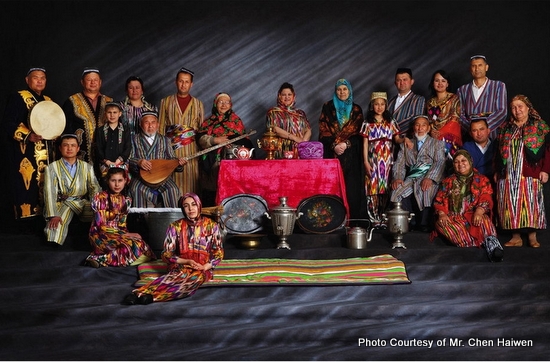The Ozbek ethnic minority, with a population of 14,800, is scattered over wide areas of the Xinjiang Uygur Autonomous Region. Most of them being city dwellers, the Ozbeks live in compact communities in Yining, Tacheng, Kashi, Urumqi, Shache, and Yecheng.
The name Ozbek first originated from the Ozbek Khan, one of the local rulers under the Mongol Empire in the 14th century. Himself a Moslem, the Ozbek Khan spread Islam in his Khanate. In the 15th century, a number of Ozbeks moved to the Chuhe River valley, where they were called Kazaks. Those who remained in the area of the Khanate continued to be known as Ozbeks, who later formed the Ozbek alliance.
The ancestors of the Ozbek group moved to China's Xinjiang from Central Asia in ancient times. In the Yuan Dynasty (1271-1368), Ozbek merchants often traveled along "the Silk Road" through Xinjiang to do business in inland areas. In the 16th and 17th centuries, Ozbek trading caravans from Buhara and Samar Khan used Yarkant in Xinjiang as an entrepot for business deals in silk, tea, chinaware, fur, rhubarb and other such products. Some Ozbek merchants moved goods to inland areas via Aksu, Turfan and Suzhou (present-day Jiuquan of Ganzu Province). During this period, Ozbeks from Central Asia began to settle in certain cities in Xinjiang, and the number grew with each passing year. Later on Ozbeks also settled in Kashi, Aksu, Yarkant and other cities in southern Xinjiang and a number of places in northern Xinjiang.
The Ozbek people have frequent exchanges with various other ethnic groups in Xinjiang, and have particularly close relations with the Uygurs and Kazaks. The Ozbek, Uygur and Tatar languages all belong to the Tuskic branch of the Altaic language family and are very close to each other. The Ozbek script is an alphabetic writing based on the Arabic letters.
The Ozbeks believe in Islam, and their customs, dressing and eating habits are basically the same as those of the Uygurs. Both men and women wear skull caps with bright colored embroidery in unique patterns, and some are made of corduroy or black velvet. Women sometimes wear scarves on top of their caps. Men wear buttonless robes reaching the knee, with oblique collars and the right side of the front on top of the other. The robe is tied with a triangular embroidered girdle. Women wear broad and pleated dresses without girdles. Ozbek men usually wear leather boots and overshoes with low-cut uppers. Women's embroidered boots are very beautiful and unique in design. The collars, front openings and sleeves of men's shirts are trimmed with colorful, patterned lace, which is typical of the handicraft art of the ethnic group.
The Ozbek people like mutton, beef and horse meat and dairy products. Crusty pancake and tea with milk are standard fare for all three meals of the day, and they enjoy stewed meat with potatoes, honey and syrup. "Naren," a mixture of minced cooked meat, onion and sour milk, dressed with gravy and pepper, is a table delicacy reserved for guests. The Ozbeks eat it with their fingers.
The Ozbeks build their houses in different designs. Some have round attics, and most are rectangular adobe houses with flat roofs. These wood and mud structures have thick walls with beautifully patterned niches, in which odd things can be placed. Patterns are also carved on wooden pillars.
The Ozbek ethnic group is one of those in Xinjiang that are good at singing and dancing and their folk music is melodious and appealing. They have a great variety of musical instruments. Most of them are plucked and percussion instruments. One string instrument with a triangular sound box is known for its sweet and appealing tone. Ozbek dances are famous for their vivacity, grace and variety. Most dances are solos, with the dancer waving her arms while turning round and round. The traditional tambourine dance is unique in style and very entertaining.





 Chinese Muslims
Chinese Muslims